接合方法・加工
Joining method/process

接合方法
Belt joining method
ベルトの接合方法はベルトの安全かつ安定した走行を得るために重要なポイントとなります。当社では独自の技術とノウハウで最も用途に適した接合方法をご提案いたします。
ふっ素樹脂ベルトの接合方法についてご説明しています。ウレタンなどの樹脂ベルトの接合法については下記ページを参照ください。
※接合効率(%)=接合部の強度/基材強度×100
-
90度オーバーラップ法
接合部強度が十分に得られ、最もスタンダードな接合方法です。高張力がかかるラインに最適です。
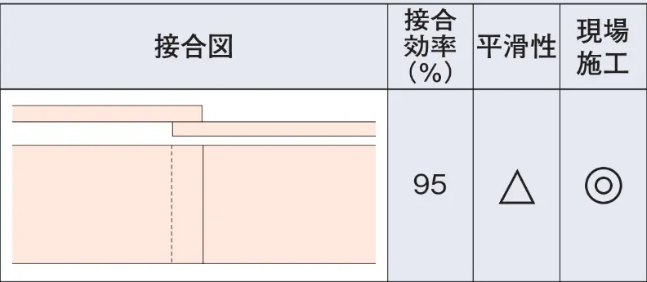
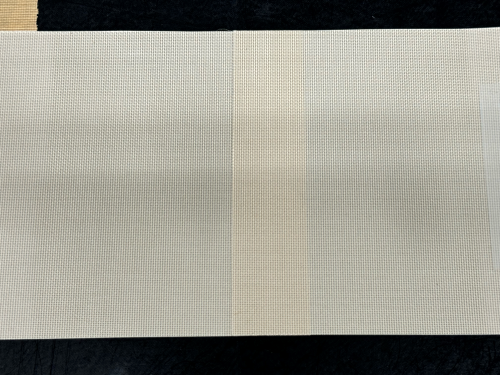
-
45度オーバーラップ法
接合部に角度をつけることにより90度接合のプーリー馴染みを改良した接合方法です。
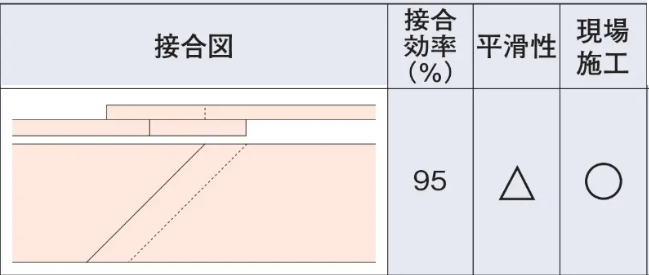
-
90度バット法
表面平滑性を重視した接合方法ですが、突き合わせ部が屈曲疲労を受けやすいという欠点があります
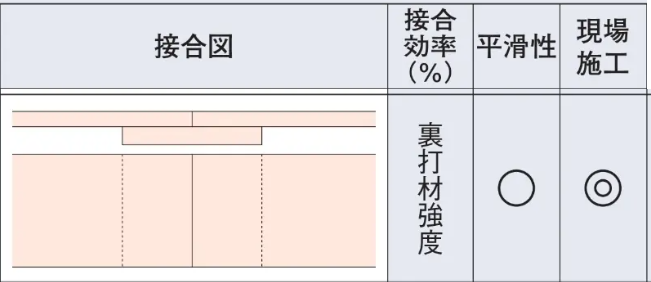
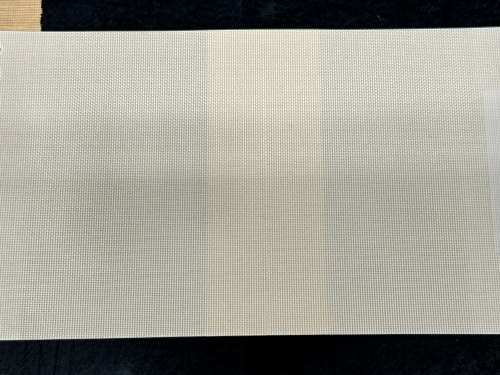
-
45度バット法
表面平滑性を重視した接合方法ですが、突き合わせ部が屈曲疲労を受けやすいという欠点があります
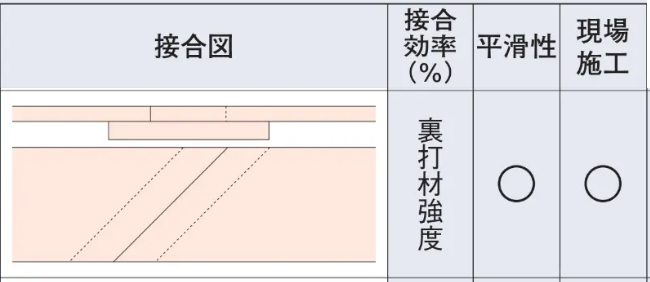
-
Vギザ法
直線カットをV型にすることにより、耐屈曲性を強化させ、さらにオーバーテープにより補強したタイプです。
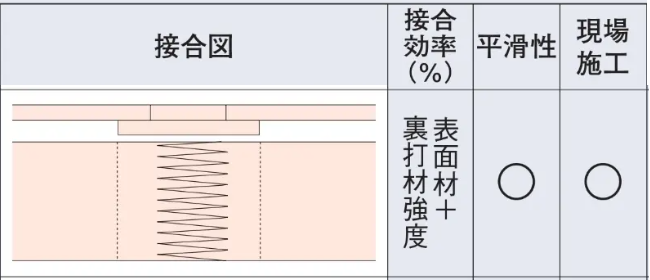
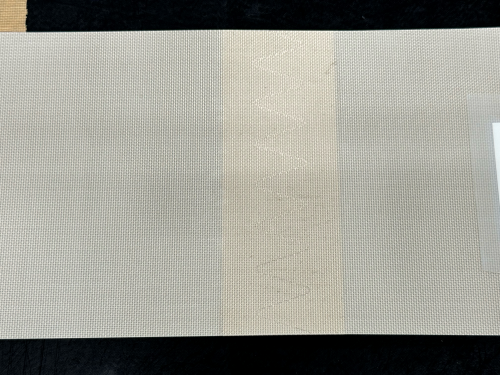
-
フィンガージョイント法
V型の形状を若干変化させたタイプで、基本的にはVギザと同様の特性を示します。
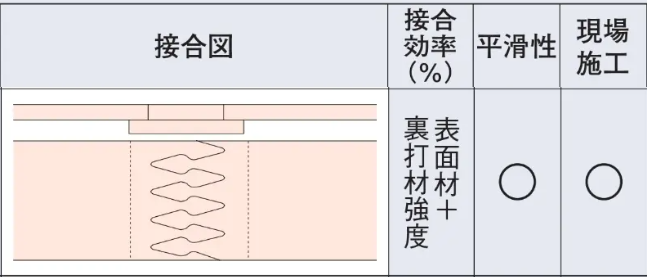
-
スカイバーオーバーラップ法
接合部強度が十分に得られ、耐屈曲性を向上させています。
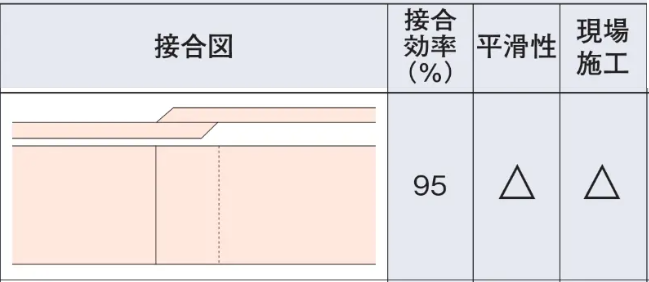
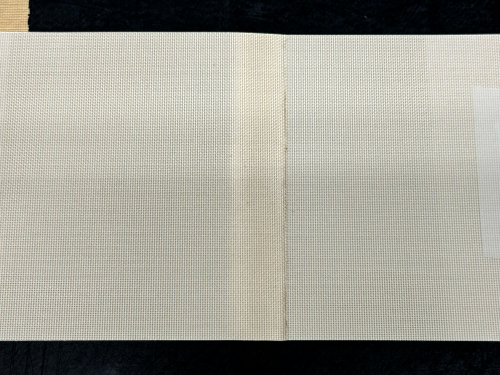
-
スカイバーバット法
表面平滑性と耐屈曲性のバランスが良好な接合方法です。
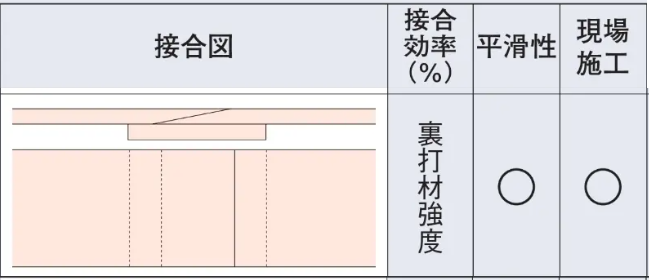
-
積層法
表面平滑性が最も優れた接合方法で、段差を嫌う用途に適しています。
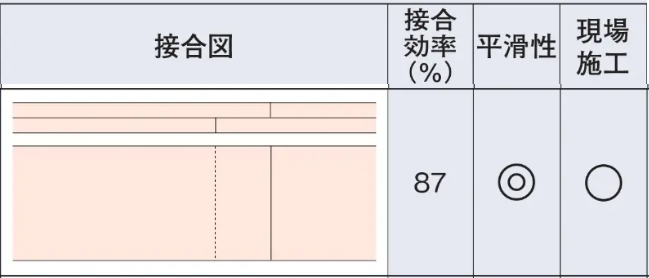
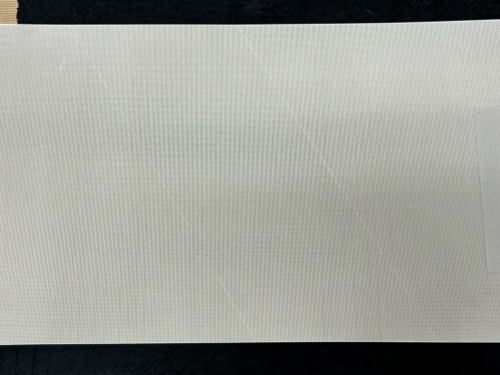
-
ラップレスジョイント法
表面平滑性耐屈曲性を持ち合わせていますが、現場での作業にあまり適していません。
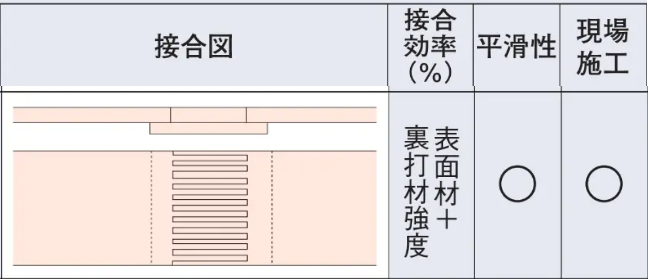
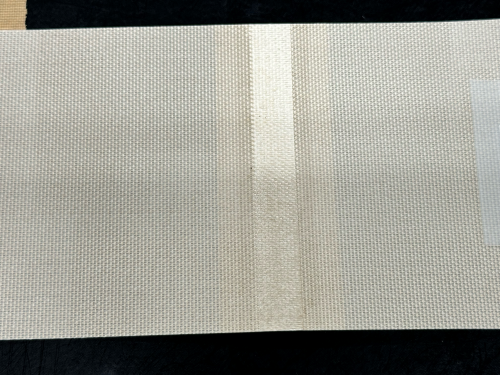
-
アリゲーター法
現場施工を容易にし、金属を嫌う現場に適しています。
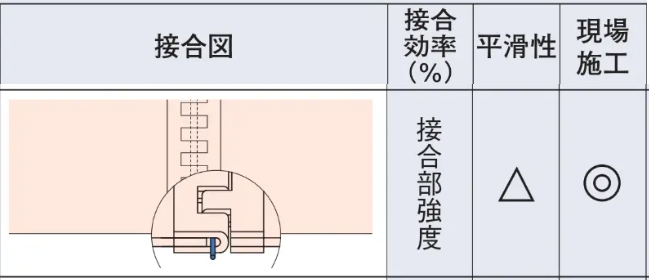
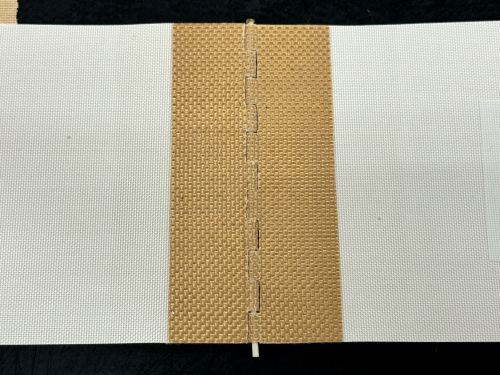
-
ウィービング法(メッシュタイプ)
メッシュベルトに使用され、適度な平滑性と耐屈曲性が得られます。通気性を求める場合にも使用されます。
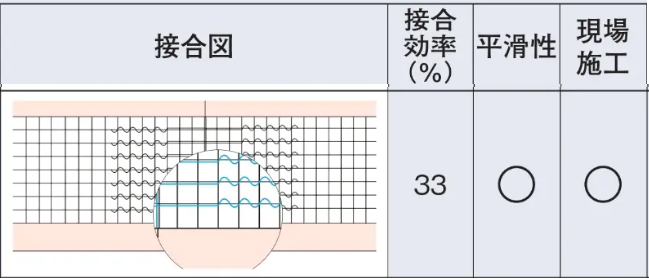
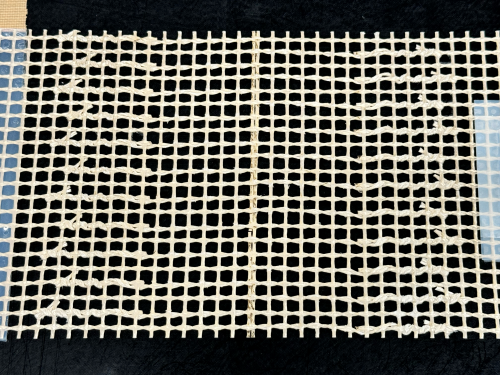
-
ループレーシング法(メッシュタイプ)
メッシュベルトに使用され、現場施工が困難な状況下で力を発揮します。

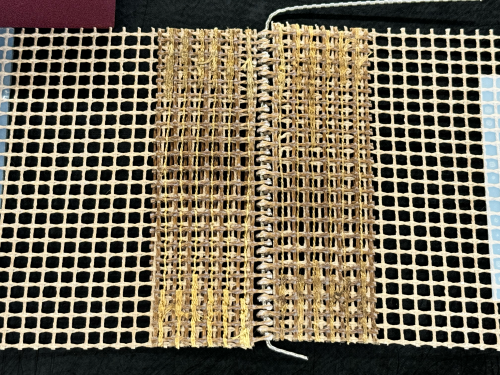
-
金具接合法
ループ部を金属にしたものでループレーシングと同様、現場施工を容易にしたタイプです。
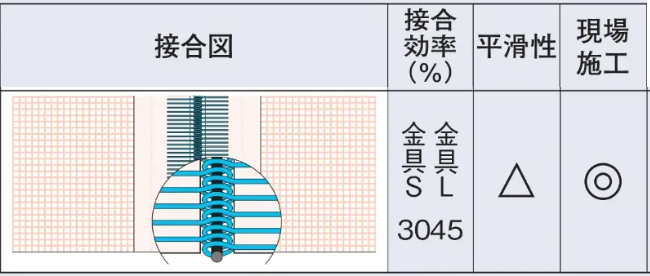
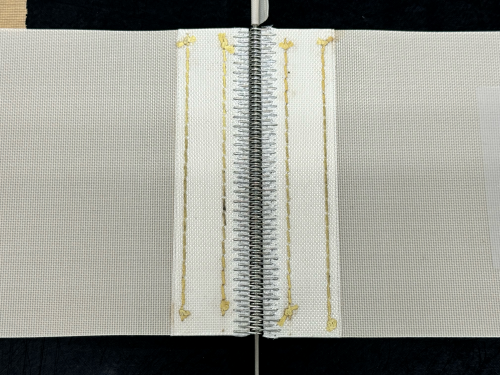
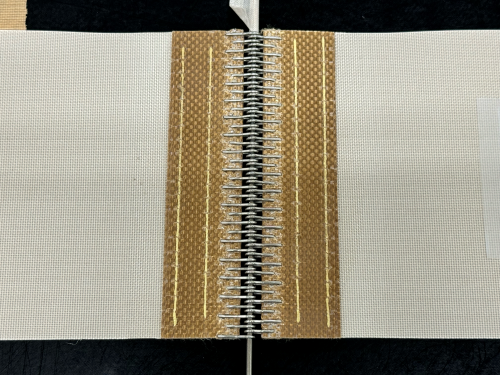
ベルト加工
Belt processing
当社はお客さまのご要望に対してより的確にお応えするため、様々なオプション加工を行っております。
-
端部補強加工
必要に応じてベルトの端部補強をいたします。

-
トゥルートラック加工
(コードサポート)ベルト裏面に装着した特殊なコードをプーリーの溝に沿って走行させることにより、蛇行、騒音のない安定したベルト走行が得られます。

-
トゥルートラック加工
(ピンサポート)ベルト裏面に装着したピンをプーリーの溝に沿って走行させることにより、蛇行のない安定したベルト走行が得られます。

-
シポネスサポート
ベルト裏面に装着したふっ素樹脂製の特殊なガイドをプーリーの溝に沿って走行させることにより、蛇行のない安定したベルト走行が得られます。
汚れにも強いシポネスサポートについてはこちらのページをご覧ください。
シポネスサポート紹介ページへ >>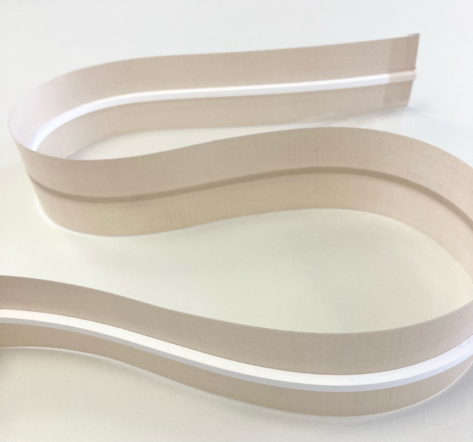
-
トラフ加工
ベルトをトラフ状に加工することで液体や粉体の搬送が可能です。

-
ラフトップ加工
Rタイプベルトの表面を凹凸状にすることで傾斜搬送の効果がアップします。(BRPタイプ・BRTタイプ)

ベルト設計上の
注意
Belt Design Notes
ベルト設計上の注意をご案内いたします。
-
プーリーの形状
プーリーは、フラットプーリーを使用します。特に走行ロスを心配の場合は駆動プーリーにゴムライニングすることをお勧めします。ライニングの厚みは、5~10mm程度とし、硬度は50(SHORE’SデュロメーターA)位が適当です。

-
プーリーの長さとベルト幅
プーリーの長さは、ベルト幅よりやや長めのものをご使用ください。ベルト幅とプーリーの長さの関係は下式を参考にして下さい。但し、トゥルートラックプーリーはこの限りではありません。
P=1.13(B+5)
P:プーリー長さ(mm) B:ベルト幅(mm) -
ベルト厚さとプーリー径
プーリー径とベルト厚さの関係は正しい伝導を得るためと、ベルトの最大寿命を確保するために重要であり、駆動プーリーについては下記の表を参考にしてその設計を行ってください。

-
使用張力の目安
ベルトの張力は一般的に使用機材(接続部)の引張強度の1/10にて設計しますが、使用張力は10N/cm以下が適正と考えられます。
特にGタイプの場合、適正張力外でのご使用はベルトの寿命を低下させるだけではなく、シワや折れが発生しやすくなり破損の原因となりますので、ご注意ください。尚、ベルト幅、接合部仕様により異なりますので当社へご相談ください。 -
駆動方式
一般的にはシングル駆動方式が多く用いられていますので、いくつかの例を下図に示します。

-
ベルト支持装置
支持装置には、キャリアローラー支持方式とプレート支持方式とがありますが、搬送物の重量、形状、搬送中の位置ずれ等を考慮の上ご選定下さい。(軽搬送用には主としてプレート方式が用いられていますが、プレート方式をご使用の際はGタイプ粘着テープのライニングをお勧めします。)
-
テンション装置
ベルトを安定して走行させるためには、常に一定の張力で作動させる必要があり、テークアップが重要な装置となります。テークアップには下図のような方式がありますが、使用条件によって設計を行って下さい。



-
ベルトの蛇行について
用途、サイズにより程度は異なりますが、伸びの少ないフッ素樹脂ベルトは蛇行する傾向があります。参考として、下記にプーリーの動きとベルトの挙動との関係を示します。
-
伸びの有無によるベルトの挙動の違い
伸びの少ないフッ素樹脂ベルトは、プーリーのどちらか片側に張力をかけた場合に、基本的にその方向と逆の方向(かかった張力を取り去る方向)に動きます。

プーリーの調整に対するベルトの挙動
用途、サイズにより程度は異なりますが、伸びの少ないフッ素樹脂ベルトは蛇行する傾向があります。参考として、下記にプーリーの動きとベルトの挙動との関係を示します。
-
オープン掛けの場合の挙動
上図参照下さい。
-
スナッププーリーがある場合の挙動
- イ) 平行度による走行調整
- スナッププーリーの平行度を下図のように調整するとベルトは↑の方向に移動します。

- ロ) 水平度による走行調整
- 各ローラーの水平度を下図のように調整するとベルトは↑の方向に移動します。

-
スナッププーリーの位置による調整方向の違い
スナッププーリーは取り付け位置によりベルトの調整方向が変化します。スナッププーリーA、Bを↑の方向に上げると(下図の手前側のみ)ベルトはA’、B’方向に動きます。
- 蛇行自動調整機
- 当社では、フッ素樹脂ベルト専用の蛇行防止装置の設計・製作を行っています。貴社のベルト仕様、設置スペース等に合わせた製作を行っています。
※ベルトの幅が500mm以上の場合にお勧めします。
- トゥルートラック方式
- トゥルートラック方式には、コードサポートタイプとピンサポートタイプの2通りあります。いずれのタイプもプーリーに溝加工を施すだけで、特別な追加設置等の必要もなくベルトの蛇行を防止することができます。
※ベルトの幅が400mm以下の場合にお勧めします。
